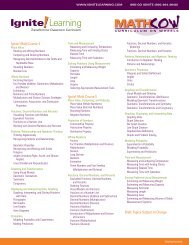The Silent Epidemic: Perspectives of High School ... - Ignite! Learning
The Silent Epidemic: Perspectives of High School ... - Ignite! Learning
The Silent Epidemic: Perspectives of High School ... - Ignite! Learning
Create successful ePaper yourself
Turn your PDF publications into a flip-book with our unique Google optimized e-Paper software.
<strong>The</strong> <strong>Silent</strong> <strong>Epidemic</strong><br />
<strong>of</strong> high school is not a sudden act, but a gradual<br />
process <strong>of</strong> disengagement; attendance patterns<br />
are a clear early sign.<br />
Slow Process <strong>of</strong> Disengagement<br />
Attendance Patterns are a Key<br />
Warning Sign<br />
As complex as these individual circumstances<br />
may be, what is clear is that dropping out <strong>of</strong> high<br />
school is not a sudden act, but a slow process <strong>of</strong><br />
disengagement, <strong>of</strong>ten both academically and<br />
socially, and is <strong>of</strong>ten influenced by a student’s<br />
perception <strong>of</strong> the high school’s expectations <strong>of</strong><br />
him or her and his or her early school experiences.<br />
26 Dropping out is not a decision that is<br />
made on a single morning. <strong>The</strong> survey probed<br />
students’ experiences before dropping out <strong>of</strong> high<br />
school and found that there are clear warning<br />
signs for at least one to three years before they<br />
drop out that these students are losing interest in<br />
school. National studies show that such warning<br />
signs appear and can be predictive <strong>of</strong> dropping<br />
out as early as elementary school. 27<br />
Students described a pattern <strong>of</strong> refusing to<br />
wake up, missing school, skipping class, and<br />
taking three hour lunches – and each absence<br />
made them less willing to go back. <strong>The</strong>se students<br />
had long periods <strong>of</strong> absences and were<br />
sometimes referred to the truant <strong>of</strong>ficer, only to<br />
be brought back to the same environment that led<br />
them to become disengaged. In our survey, 59 to<br />
65 percent <strong>of</strong> respondents missed class <strong>of</strong>ten the<br />
year they dropped out and 33 to 45 percent<br />
missed class <strong>of</strong>ten the year before they dropped<br />
out. Consistent with national data, absenteeism<br />
is the most common indicator <strong>of</strong> overall student<br />
engagement and a significant predictor <strong>of</strong><br />
dropping out. 28<br />
Other warning signs include: low grades,<br />
discipline and behavioral problems, lack <strong>of</strong><br />
involvement in class and in school activities,<br />
pregnancy, being held back a grade or more,<br />
students who transfer from another school, and<br />
those who experience difficulty with the transition<br />
year <strong>of</strong> 9th grade itself.<br />
Respondents report that they started to lose<br />
interest in school well before dropping out, with<br />
71 percent saying they lost interest in school in<br />
8<br />
the 9th and 10th grades. Fifty-eight percent <strong>of</strong> our<br />
survey respondents indicated that they dropped<br />
out in the 11th and 12th grades. Nationally, much<br />
<strong>of</strong> the dropping out <strong>of</strong> school has shifted from the<br />
last two years <strong>of</strong> high school (typical three<br />
decades ago) to between 9th and 10th grades<br />
today. 29 Still, a plurality <strong>of</strong> students drop out<br />
with less than two years to go in their high<br />
school education. 30<br />
Too Much Freedom<br />
38 Percent Say Too Much Freedom and Not<br />
Enough Rules<br />
As young adults grew older, they had more<br />
freedom and more options, which led some away<br />
from class or the school building. It was too easy<br />
to skip class or join in activities outside <strong>of</strong><br />
school. Nearly two-fifths (38 percent) <strong>of</strong> respondents<br />
to the survey cited this as a factor in their<br />
decision to drop out <strong>of</strong> high school. In our focus<br />
groups, a young man from Philadelphia told us,<br />
“Once you get in high school, it’s more like you<br />
have more freedom. In middle school, you have to<br />
go to your next class or they are going to get you.<br />
In high school, if you don’t go to class, there isn’t<br />
anybody who is going to get you. You just do your<br />
own thing.”<br />
“Too much freedom” seemed to relate to the<br />
most basic conditions in the school – lack <strong>of</strong><br />
order, discipline and rules, making sure students<br />
attended class, and even limiting chaos that<br />
made students feel unsafe. Many participants in<br />
our focus groups felt that there were many things<br />
in their lives that pulled them away from school<br />
and the new found freedom <strong>of</strong> high school made<br />
it more compelling to leave than to stay.<br />
In our Philadelphia focus groups, one boy who<br />
had just told us that his best days in school were<br />
when he worked hard and could talk about what<br />
he learned at home, lamented the fact that he<br />
only went to school once a week, and highlighted<br />
the consequences <strong>of</strong> too much freedom in the<br />
school environment. He said, in response to a<br />
question about why he only came to school once<br />
a week, the “streets would call you. Being there<br />
listening to somebody talking to you all day, writing<br />
on the board, and then you start looking<br />
outside at the streets…..We got to leave for








